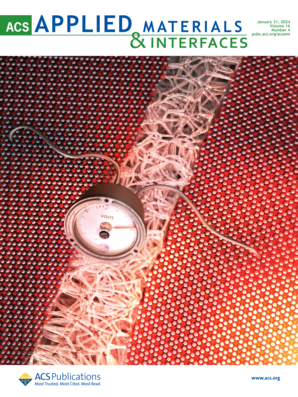Renewable and Switchable Biofunctional Modification of Poly(dimethylsiloxane) Surfaces via Host–Guest Interactions for Enhanced Capture of Circulating Tumor Cells in Microfluidics
IF 8.3
2区 材料科学
Q1 MATERIALS SCIENCE, MULTIDISCIPLINARY
引用次数: 0
Abstract
Circulating tumor cells (CTCs) are crucial for understanding cancer metastasis. Poly(dimethylsiloxane) (PDMS) microfluidic chips utilizing aptamers (APTs) effectively separate CTCs, but the hydrophobicity of PDMS causes issues with nonspecific adsorption and reduces cell viability. Therefore, it is imperative to develop innovative surface modification techniques for PDMS to enhance its biocompatibility and optimize its performance in microfluidic applications. In this study, oligo(ethylene glycol) methacrylate (OEGMA) and adamantane-modified OEGMA were copolymerized onto an initiator-containing PDMS surface. Poly(OEGMA) prevents nonspecific adsorption, and biotin-modified β-cyclodextrin (β-CD) was introduced through host–guest interaction between β-CD and adamantane. By using the biotin–streptavidin interaction, streptavidin and biotin-modified aptamers (TD05 APT and Sgc8 APT) were sequentially immobilized on the copolymer-grafted PDMS substrate. The data indicate that the PDMS substrate functionalized with TD05 APT achieved a capture efficiency of 91% and a selectivity of 30.2 for Ramos cells, while the substrate functionalized with Sgc8 APT achieved a capture efficiency of 93% and a selectivity of 33.3 for CEM cells. Furthermore, treating the APT-functionalized surfaces with sodium dodecyl sulfate released the β-CD component, allowing for the regeneration and switching of the surface biofunctionality by reimmobilizing TD05 APT or Sgc8 APT. Finally, the PDMS microfluidic chips modified using this strategy achieved high capture efficiency (96% for Ramos cells, 93% for CEM cells) and high selectivity (11.4 for Ramos cells, 9.2 for CEM cells). The host–guest chemistry endows the modified PDMS substrate with renewable and switchable biofunctionality, offering insights into the potential applications in the isolation and enrichment of CTCs.

通过宿主-客体相互作用对聚(二甲基硅氧烷)表面进行可再生和可切换的生物功能修饰,以增强微流体中循环肿瘤细胞的捕获
循环肿瘤细胞(CTCs)是了解肿瘤转移的关键。利用适体(APTs)的聚二甲基硅氧烷(PDMS)微流控芯片可有效分离ctc,但PDMS的疏水性导致非特异性吸附问题,降低了细胞活力。因此,开发创新的PDMS表面改性技术以提高其生物相容性并优化其微流控应用性能是势在必行的。本研究将低聚(乙二醇)甲基丙烯酸酯(OEGMA)和精胺改性OEGMA共聚在含引发剂的PDMS表面。聚(OEGMA)防止非特异性吸附,并通过β-CD与金刚烷的主客体相互作用引入生物素修饰的β-环糊精(β-CD)。利用生物素-链霉亲和素的相互作用,将链霉亲和素和生物素修饰的适配体(TD05 APT和Sgc8 APT)依次固定在共聚物接枝的PDMS底物上。数据表明,用TD05 APT功能化的PDMS底物对Ramos细胞的捕获效率为91%,选择性为30.2,而用Sgc8 APT功能化的底物对CEM细胞的捕获效率为93%,选择性为33.3。此外,用十二烷基硫酸钠处理APT功能化的表面,释放β-CD成分,通过重新调动TD05 APT或Sgc8 APT,允许表面生物功能的再生和切换。最后,使用该策略修饰的PDMS微流控芯片获得了高捕获效率(拉莫斯细胞96%,CEM细胞93%)和高选择性(拉莫斯细胞11.4,CEM细胞9.2)。主客体化学使改性的PDMS底物具有可再生和可切换的生物功能,为ctc的分离和富集提供了潜在的应用。
本文章由计算机程序翻译,如有差异,请以英文原文为准。
求助全文
约1分钟内获得全文
求助全文
来源期刊

ACS Applied Materials & Interfaces
工程技术-材料科学:综合
CiteScore
16.00
自引率
6.30%
发文量
4978
审稿时长
1.8 months
期刊介绍:
ACS Applied Materials & Interfaces is a leading interdisciplinary journal that brings together chemists, engineers, physicists, and biologists to explore the development and utilization of newly-discovered materials and interfacial processes for specific applications. Our journal has experienced remarkable growth since its establishment in 2009, both in terms of the number of articles published and the impact of the research showcased. We are proud to foster a truly global community, with the majority of published articles originating from outside the United States, reflecting the rapid growth of applied research worldwide.
 求助内容:
求助内容: 应助结果提醒方式:
应助结果提醒方式:


